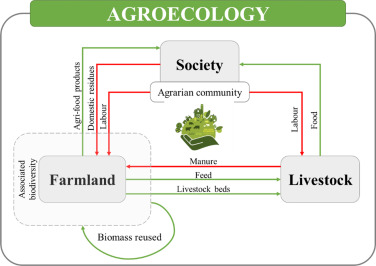The global food system faces mounting pressure from climate change, biodiversity loss, and soil degradation. Conventional agriculture, reliant on synthetic inputs and intensive land use, contributes significantly to these challenges. Industrial farming practices have led to widespread soil degradation, water shortages, and an over-reliance on chemical fertilizers and pesticides.
In response, the transition to agroecology, a farming approach that integrates ecological principles into agriculture, has gained momentum as a sustainable alternative.
Agroecology is more than just an alternative farming technique; it is a holistic approach that harmonises agricultural productivity with nature.
This method emphasises soil regeneration, biodiversity, and reduced chemical dependence to ensure long-term food security. As governments, scientists, and farmers look for sustainable solutions, agroecology is emerging as a transformative force in modern agriculture.
What is agroecology?

Agroecology is a science-driven, practice-based approach that integrates ecological principles into farming. Unlike industrial agriculture, which prioritises high-yield monocultures, agroecology focuses on diversification, soil health, and ecosystem balance.
The Food and Agriculture Organisation (FAO) of the United Nations defines agroecology based on 10 key elements, including diversity by encouraging multiple crops and livestock varieties to improve resilience, efficiency by reducing external inputs such as chemical fertilizers and pesticides, resilience by enhancing the ability of farming systems to withstand climate shocks, co-creation of knowledge by encouraging traditional and scientific farming knowledge, and human and social values by prioritising fair livelihoods for farmers and communities.
By incorporating these principles, agroecology provides a long-term solution to many of the environmental and economic challenges posed by conventional agriculture.
Benefits of agroecology include the following:
- Restoring soil health
Soil degradation is one of the most pressing issues in modern agriculture. Over 40% of the world’s soil is degraded due to erosion, salinisation, and nutrient depletion caused by excessive ploughing and chemical overuse, reports the UN Global Land Outlook. Agroecological practices, such as composting, mulching, and cover cropping help rebuild soil fertility, improve water retention, and store more carbon, mitigating climate change effects. A study in Ethiopia found that agroecological methods improved soil organic matter by 32%, increasing productivity and reducing dependence on synthetic fertilizers, going by findings of the Department of Agriculture and Food.
- Enhancing biodiversity
Biodiversity is crucial for food security as it strengthens ecosystems and promotes natural pest control. Industrial farming often leads to pollinator loss, soil microbiome destruction, and over-reliance on pesticides.
Agroecology encourages polycultures by growing multiple crops together to improve pest resistance, agroforestry by integrating trees into farms to provide shade, improve soil health, and boost biodiversity, natural pest management by using biological controls instead of synthetic pesticides.
A report by soil associations highlights how increasing biodiversity on farms leads to 20% higher crop yields while significantly reducing pesticide use. In France, vineyards using agroecological methods saw a 70% reduction in pesticide use without sacrificing yield quality.
- Climate change mitigation and adaptation
With extreme weather events becoming more frequent, climate-resilient farming is urgent. Agroecological practices reduce greenhouse gas emissions by eliminating carbon-intensive farming methods.
Techniques like no-till farming reduces soil erosion and boosts carbon sequestration. Intercropping improves resilience to drought and flooding, and water conservation methods reduces dependency on irrigation by retaining soil moisture.
According to the World Economic Forum, shifting to agroecology could reduce agriculture’s emissions by up to 30% while improving soil’s ability to absorb carbon dioxide. Indian farmers adopting agroecological methods reduced methane emissions from rice paddies by 42% while maintaining high productivity.
- Economic and social benefits
Agroecology supports environmental health while improving farmers’ livelihoods. The FAO’s Tool for Agroecology Performance Evaluation (TAPE) found that farms practicing agroecology spend 50% less on fertilizers and pesticides. Smallholder farmers experience higher profitability due to premium-quality organic produce.
Agroecological farms demonstrate better resilience during economic downturns. Countries like Brazil and India have already implemented policies to support agroecological farming through subsidies, education, and research investment. In Brazil, agroecological farms were 20% more profitable than conventional farms due to reduced input costs and increased soil fertility.
Challenges and the way forward
Despite its numerous benefits, agroecology faces barriers such as slow adoption, lack of policy support, and knowledge gaps. Industrial farming still dominates global food production, making it difficult for agroecological farms to compete. However, some nations are integrating agroecological principles into national policies, providing a model for others to follow.
To accelerate the transition, governments and agricultural stakeholders must invest in farmer education and training on agroecological practices, develop policies that support sustainable farming over industrial agriculture, encourage research on agroecological innovations, large-scale implementation, and introduce financial incentives for farmers adopting regenerative farming.
Conclusion
Agroecology represents the future of sustainable food production. By restoring ecosystems, enhancing biodiversity, and improving resilience to climate change, it offers a viable path towards a more secure and environmentally-friendly food system. However, scaling adoption and integrating agroecology into mainstream agricultural policies require global cooperation.
The transition is not just about changing farming practices, it is about transforming how we think about food production, the environment, and our relationship with nature. Governments, researchers, and consumers all have a role in ensuring that agroecology becomes the standard rather than the exception. If widely adopted, agroecology has the potential to transform agriculture into a regenerative, resilient, and climate-friendly industry, ensuring food security for future generations.



